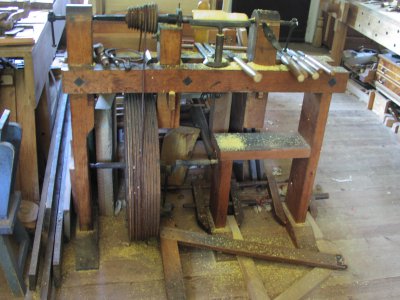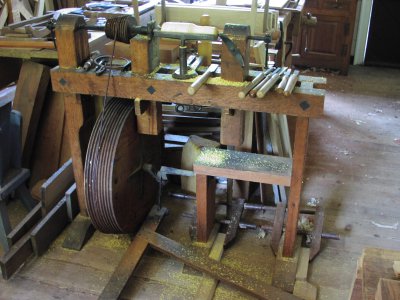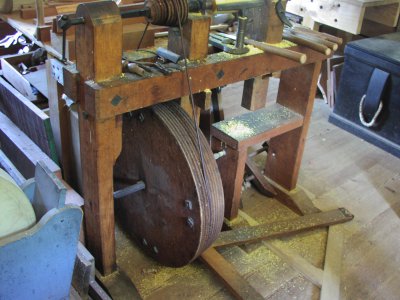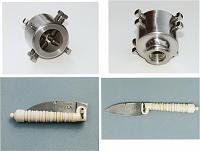- Joined
- Jul 26, 2011
- Messages
- 4,142
I posted a picture of this in the "flux" thread. But it is sort of hidden there,so I'm putting it out where it can be seen. I don't understand this new picture posting method here. When I push the "upload" button,it doesn't change color,or seem to respond to being pushed. I was only able to get one picture to post before. I'll try again here.
P.S.: O.K.,better luck this time.
This is really a metal lathe copied from an original in the Science Museum in London. It was made for the Gunsmith's Shop in Colonial Williamsburg while I was toolmaker there. When that shop moved to the Geddy Foundry site,they already had a lathe there,and no space for this one. So,it is now in the Cabinet Shop.
The flywheel is 24" in Dia.,and 5" thick. That gives it enough oomph to take cuts from metal (small parts!) The blacksmith's shop made rough forgings,and I finished them,turning threads on the spindle,threading the various parts,etc.
The stepped pulleys are ONLY to tighten the ever stretching belt,not to change speeds. You treadle faster to do that.
The front end of the spindle is tapered,and runs through a tapered hole in a 1/2" plate of tool steel. That must be kept lubed. There is no spindle hole. The rear end of the spindle has a hardened point on it,running against an adjustment bolt.
I actually made several attachments for this lathe,like a cat head chuck,face plate,pitch chuck,and forked center. Those stayed with the other lathe. It had the same 1" x8 thd. nose.
There is a picture of the cat head chuck. It is a dangerous item!! Those bolts center up the work by eye,but stick out like cat's whiskers to bark your knuckles pretty badly! The cat head chuck is the early equivalent of a 4 jaw chuck. They had no 3 jaw. Their metal was rolled so crudely,it was not practical to put it into a 3 jaw self centering chuck anyway.
There is an ivory handled folding knife seen there,too. Nothing to do with the lathe. Just an early type knife I made for a customer. About 4"long,closed. Half ram nut to tighten the blade open or closed. Too bad this picture won't enlarge.
The pitch chuck is a cast iron bowl filled with pitch. It screws onto the spindle. You can heat it up and press really odd shaped parts into it. Then,put it onto the lathe,and nudge the part till it runs true. Then,when the pitch cools,it holds well enough to allow careful turning on whatever part you made to run true. Mostly for things like candle stick bases. A pretty handy thing,actually. It can hold things you can't hold any other way.
The lathe is about 12" swing,24" between centers,IF I recall correctly. Been quite a few years.
IF YOU ENJOY THESE PICTURES,please comment. When I see 215 views,and 2 replies,I think I may be wasting my time posting. Thank you.




P.S.: O.K.,better luck this time.
This is really a metal lathe copied from an original in the Science Museum in London. It was made for the Gunsmith's Shop in Colonial Williamsburg while I was toolmaker there. When that shop moved to the Geddy Foundry site,they already had a lathe there,and no space for this one. So,it is now in the Cabinet Shop.
The flywheel is 24" in Dia.,and 5" thick. That gives it enough oomph to take cuts from metal (small parts!) The blacksmith's shop made rough forgings,and I finished them,turning threads on the spindle,threading the various parts,etc.
The stepped pulleys are ONLY to tighten the ever stretching belt,not to change speeds. You treadle faster to do that.
The front end of the spindle is tapered,and runs through a tapered hole in a 1/2" plate of tool steel. That must be kept lubed. There is no spindle hole. The rear end of the spindle has a hardened point on it,running against an adjustment bolt.
I actually made several attachments for this lathe,like a cat head chuck,face plate,pitch chuck,and forked center. Those stayed with the other lathe. It had the same 1" x8 thd. nose.
There is a picture of the cat head chuck. It is a dangerous item!! Those bolts center up the work by eye,but stick out like cat's whiskers to bark your knuckles pretty badly! The cat head chuck is the early equivalent of a 4 jaw chuck. They had no 3 jaw. Their metal was rolled so crudely,it was not practical to put it into a 3 jaw self centering chuck anyway.
There is an ivory handled folding knife seen there,too. Nothing to do with the lathe. Just an early type knife I made for a customer. About 4"long,closed. Half ram nut to tighten the blade open or closed. Too bad this picture won't enlarge.
The pitch chuck is a cast iron bowl filled with pitch. It screws onto the spindle. You can heat it up and press really odd shaped parts into it. Then,put it onto the lathe,and nudge the part till it runs true. Then,when the pitch cools,it holds well enough to allow careful turning on whatever part you made to run true. Mostly for things like candle stick bases. A pretty handy thing,actually. It can hold things you can't hold any other way.
The lathe is about 12" swing,24" between centers,IF I recall correctly. Been quite a few years.
IF YOU ENJOY THESE PICTURES,please comment. When I see 215 views,and 2 replies,I think I may be wasting my time posting. Thank you.




Last edited:
